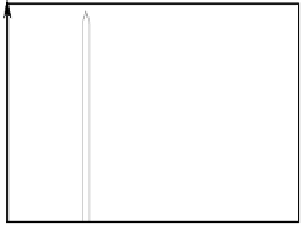Information Technology Reference
In-Depth Information
max
high
med
zero
2
2
1
1
0
0
Fig. 4.
Abstracting a continuous state evolution to a qualitative trace
levels in the two tanks have the quantity spaces
T
1=
df
{
Zero,
Empty
,
Ful l
}
and
T
2=
df
{
respectively (see Figure 3). Remember that
the implicit intervals between the landmarks are part of the quantity spaces.
The flow rates have the quantity space
FR
=
df
Zero,
Empty
,
Reserve
,
Ful l
}
{
Zero,Max
}
. We also need
to introduce auxiliary quantities in order to be able to set up the QDEs. The
auxiliary quantities
diff
1
and
diff
2
have to link the different QDEs. Hence, they
only need a coarse quantity space
NZP
=
df
{
minf
,Zero,
inf
}
.
We use two types of qualitative constraints
to formulate the QDEs of the water tank exam-
ple:
add
and
d/dt
. The constraint
add
(
x, y, z
)
denotes the qualitative addition of two qualita-
tive values
x
+
y
=
z
. It is defined over sign
algebra and simply expresses facts like that two
positive qualitative values will also be positive,
etc. Table 1 shows the full definition of this qualitative addition. Note that in
contrast to the real-valued algebra, here the addition is a relation rather than a
function. This is because the result of adding opposing signs cannot be uniquely
determined. The second constraint
d/dt
(
x, y
) denotes that
y
is the qualitative
derivation of
x
. This means that the sign of
y
determines the direction of change
of
x
. The qualitative model of the two-tank system is given by the conjunction
of the following QDEs:
Table 1.
Qualitative Addition
add
+0 -
+
+
+ +/0/-
0
+0 -
-
+/0/-
-
-
add
(
diff
2
,
out
,
inout
)
∧
add
(
diff
1
,
inout
,
in
)
∧
d/dt
(
x
1
,
diff
1
)
∧
d/dt
(
x
2
,
diff
2
)(2)
Since QR only deals with symbolic values and monotonic function relations
(e.g., if
x
increases then
y
decreases) constant factors have no influence on the
qualitative behavior. For example, the continuous functions
f
1
(
t
)=
t
2
and
f
2
(
t
)=


















































































